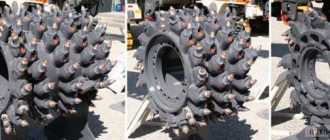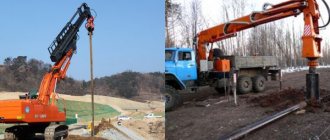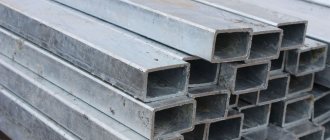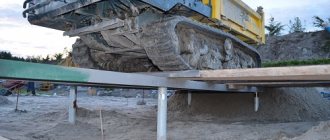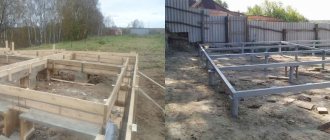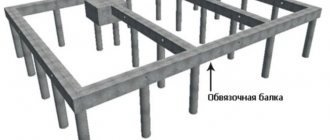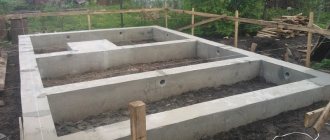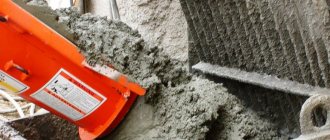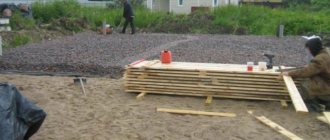Technology for installing screw piles Reinforced concrete bridge piles Guidelines for the design of pile foundations
The main purpose of piles is to take the load from the structure and transfer it to the ground.
They are long rods made of various materials that are installed in the ground. Piles are classified according to the following criteria:
- By material
There are wooden, concrete, reinforced concrete and metal piles.
- By immersion method
Piles can be screwed, driven, bored, vibrated, or pressed.
- By interaction with the ground
Piles can transfer the load to the rocky soil directly - then they are called rack piles, or use friction to distribute the weight of the building - this is done by hanging piles.
What is a pile foundation
A pile foundation is a system of vertical supports immersed in the ground to the level of full contact with dense layers. Used for construction in wetlands, peat bogs, loose sand and other unstable soils.
The piles are immersed in the ground, and the upper part is tied around the perimeter with a grillage - a kind of analogue of a strip base, forming a direct support for the load-bearing walls.
The grillage can be located above the ground surface, flush with it, or submerged to a certain depth.
At the same time, only the piles have direct support on the ground, and the grillage only transfers the load from the weight of the house to them, without resting on the ground independently.
NOTE!
There is a pile-strip type of foundation, very similar to a pile-grillage foundation. The difference is that the design of the pile-tape foundation provides equal support on the ground for both the tape and the piles.
Advantages of screw piles
Screw piles have the following advantages:
- lack of excavation work;
- the possibility of house construction on difficult terrain and weak soil;
- ease of installation on ready-made architecturally formed sites;
- high load-bearing capacity;
- no shrinkage;
- possibility of installation near communications and at any time of the year;
- durability.
A foundation made of screw piles is used on soft soil, where there is high humidity, freezing and fluidity. It will not be possible to build a basement with it, but this drawback is typical for all types of pile foundations.
When choosing screw piles, you should pay attention to the following factors.
- The basis is a new steel pipe with sandblasting and a reliable anti-corrosion coating. The wall thickness must be at least 4 mm, and the blades must be more than 5 mm.
- The outside of the pipe should be smooth, without protruding welds, and the blade should be of the correct shape.
- High demands are placed on the quality of welding, otherwise the connections will not withstand being screwed into the ground.
The following types of screw piles exist:
- cast, with high strength of connection between the blade and the pipe;
- welded - with blades welded onto the body of the pile;
- combined, assembled from two parts - blades with a cone.
Screw piles are not installed in rocky and rocky soil, although there is special equipment for such installation.
Types of piles according to the principle of operation
According to the type of load transfer to the supporting layers of soil, there are two types of piles:
- Hanging . The support is formed due to the resistance of the soil applied to the side surfaces and pointed ends of the pile. The immersion depth is relatively shallow.
- Rack piles . They are immersed in the ground until full contact with dense, incompressible layers of soil occurs. The depth of immersion can reach significant values.
Frictional piles have a lower load-bearing capacity because they rely on friction. With changes in the composition of the soil (increasing groundwater levels), the adhesion force of the side surfaces weakens and the support becomes less resistant to subsidence.
Rack piles have high load-bearing capacities that do not change with changes in the condition of the upper layers of the soil. At the same time, the immersion depth can reach up to 20 m, which requires the use of powerful construction equipment.
According to the barrel manufacturing method
There are several options for making a pile shaft:
- Monolithic . They are a trunk made of a solid mass of material (wooden, reinforced concrete).
- Hollow (shell) . They are a type of pipe filled with various materials to increase the load-bearing capacity, or left empty.
In turn, hollow piles are:
- Non-refillable . They are immersed in the ground without additional actions. They are used in situations where the wall thickness is sufficient to create the necessary load-bearing capacity.
- Pipe concrete . After immersion, the outer pipe is filled with concrete to increase strength.
- Shell pile . It has no load-bearing capacity and is a form for pouring concrete.
- Temporary shell . It is a movable pipe, which, after pouring concrete, is moved to a new location.
- Shellless design . Concrete is poured directly into the well. Allowed if the soil composition and condition are appropriate.
One of the most common types of hollow supports are bored piles, which are widely used in construction due to the absence of the need to use a construction pile driver for driving.
They allow construction work to be carried out close to existing buildings and do not pose a danger to their condition.
Piles: types of immersion
Piles made of any material are divided into hanging and racks. The first ones are used for soft soils of great depth. They transmit the load not only by the lower end, but also by friction between the ground and the side surface. The racks rest with their lower end on a dense base, which absorbs the entire load.
Pile designs are interrelated with the driving method and are of the following types.
- Driving - using hammer blows, using vibrators or pressing devices. The method is used if there are no other structures nearby that could cause settlement due to ground shaking.
- Hollow shell piles. They are immersed in the ground by vibration, removing the soil from inside and replacing it with concrete mortar.
- Drilling - wells are drilled and filled with a mixture of concrete with reinforcement or a reinforced concrete element.
- Driven - a well is made by squeezing the soil and filled with concrete mixture.
- Screw - screwed into the ground.
Types by material of manufacture
Materials for making piles can be:
Wood
A traditional type that appeared many centuries ago, but is still used in construction. Massive and heavy buildings are no longer built on wooden piles, but this material is used quite often for light auxiliary buildings.
Both logs and beams are used. A situation often arises when construction conditions require piles of greater thickness than the size of tree species growing in the region allows. In such cases, batch splicing of several beams is carried out, giving the required thickness and length of the pillars.
The optimal conditions for using wooden piles are constantly moist soils . If water appears and disappears, the wood begins to rot and the pile will have to be replaced.
They are made from different types of trees, mainly coniferous, but when deciduous trees predominate in the region, piles are made from them.
The main method of driving wooden piles is driving them using a construction pile driver. To protect the upper part, a special cap is used to protect the material from splitting or riveting.
Before immersion, the material is primed with a special composition that protects it from various types of external influences.
IMPORTANT!
There should be no pests in the soil, otherwise the supports will quickly be destroyed.
Metal
Ready-made metal products are used as piles. These include pipes with a diameter of 26 cm or more . The exception is screw piles, whose diameters are much smaller.
In addition to pipes, I-beams, channels and other rolled profiles of the appropriate size can be used. Pipe immersion is carried out in closed and open form. For closed immersion, a conical metal tip is welded to the lower end, facilitating the passage of the barrel through layers of soil.
Open immersion is carried out with the free end of the pipe . Soil penetrates into the hole, forming a solid plug at the lower end of the pile cavity. It compacts the lower areas when immersed, which begin to serve as the tip.
A separate type of metal supports are screw piles. They are specially made and look like a pipe with a conical tip. two or three pairs of blades are welded at a short distance from it.
Driving such a pile resembles the process of screwing in a screw. Screw piles can be driven using construction equipment or manually . To do this, a gate is installed on the upper part and rotation is performed, due to which the pile goes underground.
In this way, you can work in close proximity to residential or auxiliary buildings without causing any harm to them.
Concrete
Reinforced concrete piles are the most common option. They are manufactured specially in standard sizes or poured into a prepared well directly at the construction site.
Finished piles represent the most durable support with stressed reinforcement. Such trunks have maximum resistance to lateral loads, common for wet heaving soils.
Cast piles are much cheaper, but installation takes a long time, which is necessary for the concrete to gain structural strength . Finished piles are square beams with a side of 20 to 40 cm with a pointed working end.
For immersion to depths exceeding 12 m, prefabricated piles are used in the form of pipes with a wall thickness of 4 cm.
They are immersed in the ground, connecting along the length to reach the required depth.
Installation of screw piles
- The appropriate standard size of piles is selected based on calculations and soil analysis.
- Marking is made and the pile is installed in the required location.
- Screwing is done using a special technique, but sometimes it can be done manually, using levers. The work is performed by 2-3 people. The depth should not be less than 1.5 m.
- The pile field is cut one level at a time.
- Concrete can be poured inside the pipes.
- The caps are welded on top of the piles, and then they are tied with a channel or logs. Welding seams are coated with anti-corrosion mastic.
Varieties by immersion method
Pile driving is done in different ways:
- Indentation.
- Casting.
- Screwing.
Let's take a closer look at them:
Indentation
A technical term for driving piles using a pile driver or hammer. Produced using specialized equipment.
The technology is quite reliable and productive, allowing diving to great depths.
The disadvantage is strong ground vibration, which negatively affects nearby buildings.
Casting
The technology consists of drilling a well to the entire depth of the pile. After this, formwork is installed in it (a pipe made of polyethylene or roofing felt), and a reinforcing frame is immersed . Then the concrete is poured.
The finished pile is kept for the required time to gain structural strength.
NOTE!
It is impossible to reduce the concrete hardening time specified by the project; this can cause destruction of the foundation and the building.
Screwing
This procedure is used when installing screw piles. The work is done quite quickly . The advantage of this type is the ability to do the work manually, without the use of construction equipment.
When screwing, it is necessary to immediately align the position of the barrel vertically.
Reversing such supports during installation is contraindicated, as it disrupts the adhesion strength of the blades to the ground..
Bored piles
The types of foundation piles also include structures manufactured directly on the construction site.
The bored support is made as follows.
- A hole is made in the ground to the depth of the pile. To do this, the soil is drilled or pierced. With the first method, soil walls can be strengthened with casing pipes or clay mortar. When the bottom mark is reached, the space under the base is expanded with a special device mounted on the drill rod.
- A pipe made of roofing felt and a formwork of four reinforcement rods with horizontal dressings are inserted into the well.
- The internal space is filled with concrete mortar and compacted with a vibrator.
Which classification is best for private construction?
The selection of the most suitable type of piles is made at the design stage. It is determined by the parameters of the building - weight, number of storeys, material used . In addition, the type of soil, working conditions, the presence of nearby buildings and other factors are taken into account.
By comparing the available initial data, we come to the choice of the most convenient, effective and safe type of piles. Typically, preference is given to bored (cast) piles, which do not require driving and do not cause damage to nearby buildings and structures.
Recently, screw piles have been actively used, allowing construction without preliminary excavation work (work on uneven terrain is allowed).
Determining the diameter of the supports
Screw piles, which are used when installing foundations for residential and commercial buildings, have a diameter of 57, 76, 89 and 108 mm . This parameter is selected depending on the weight of the finished structure:
- 57 mm - used for the construction of the simplest and lightest structures (fences and fences made of chain-link mesh);
- 76 mm - chosen as the basis for lightweight outbuildings or fences made of wood or corrugated board. The bearing capacity of such elements does not exceed 3000 kg;
- 89 mm - used where the load-bearing load will not exceed 5000 kg. This is an excellent solution for the construction of a one-story building (frame or panel), baths, summer kitchens, sheds and massive fences;
- 108 mm - foundation a site for the construction of a house made of foam blocks, wooden beams, frame (1-2 floors) with light weight. The bearing capacity of screw piles of this diameter reaches 7000 kg.
Related article: How to make a foundation for an extension to a house
The diameter of the elements depends on the weight of the building
DRIVEN COMPOSITE REINFORCED CONCRETE PILES OF SQUARE (CONTINUOUS) SECTION
Driven composite reinforced concrete piles of square (solid) cross-section are recommended to be used provided that the joint design can withstand axial indenting and horizontal loads and bending moments (and for foundations with pull-out loads, also tensile forces.
Composite piles are recommended to be used:
a) if it is necessary to deepen piles into the load-bearing layer (the roof of which has an irregular position within the contours of the designed building (structure);
b) when it is difficult to transport long elements (caused by cramped road transport conditions or cramped conditions of the construction site;
c) in the absence of pile driver equipment (necessary for driving piles longer than 12-14 m;
d) if it is possible to reduce the cross-sectional dimensions of the piles (if the bearing capacity of such piles satisfies the design load.
The use of composite piles allows them to be manufactured in forms (available at factories of reinforced concrete products for shorter prismatic piles (and the driving of such piles is carried out using small-height pile drivers available to construction organizations.
DRAWN PILES (INSTALLED IN PUNCHED WELLS
Wells for such piles are constructed by driving in removable inventory pipes with a shoe (left in the ground) or by driving in inventory casing pipes with a core of densely compacted rigid concrete mixture at the bottom of the pipe.
Cast-in-place piles in drilled holes differ from bored-in-place piles in a higher degree of utilization of the bearing capacity of the foundation soils (approaching that of driven-in piles.
Cast-in piles (installed in punched holes (it is recommended to use them in soil conditions (similar to those for driven piles (clauses 2 and 3 of these Recommendations))) especially in cases (when it is difficult to obtain prefabricated reinforced concrete piles (or when the built-up area is characterized by a sharp fluctuation in the occurrence of dense load-bearing layer soils.
Currently, new types of driven piles are being introduced in construction (including: with widening in the lower part (club-shaped), pyramidal (diamond-shaped, etc.
When introducing new pile designs in order to accumulate construction experience (as well as to justify the possibility of their wider use), establishing a nomenclature of piles and identifying the feasibility of their typification, it is necessary to test the specified piles and monitor their operation.
Grillage design for a foundation on piles
Scheme for calculating the number of piles.
A pile foundation with a grillage will give the structure reliability and durability and give it rigidity. You can build a grillage from prefabricated reinforced concrete elements or pour a monolithic foundation. A pile foundation with a monolithic grillage is the most profitable solution for independent construction, since pouring concrete is less labor-intensive than installing heavy reinforced concrete blocks.
When selecting soil for a grillage, it is necessary to fulfill a number of conditions: firstly, the surface of the trench must be placed strictly horizontally, and secondly, after the production of bored piles, the laying depth must be more than 200-300 mm from the surface of the earth. With a concrete layer thickness of 400-500 mm, reinforcement can be performed and tied to piles. After preparing a trench along the perimeter of the foundation, using a garden drill, holes with a cross-section of 120-150 mm are made to a depth below the freezing point of the soil, but not less than 500 mm. The pitch of the piles is determined to be 2-3 m. Expand the base of the pit to 25-35 cm in diameter from the bottom mark to a height of 30 cm, pour sand in a layer of at least 50 mm and compact it. Insert a shell of glassine or roofing felt into the hole according to the thickness of the pile, install the reinforcement cage and fill with concrete. Reinforcement of piles is carried out with the release of reinforcement 400-500 mm.
Experts recommend using ready-made concrete, but it can also be prepared independently. Sand and gravel must be free of soil and clay. The ratio of components is as follows: 70-55% gravel, 30-45% sand. The grade of cement used must be at least 300. It is worth remembering that the quality of concrete increases only up to a certain amount of cement. An unjustified increase in the rate of cement reduces the quality and strength of concrete. To prepare 1 m³ of ready-made concrete mixture you need: sand (550 kg), cement grade 400 (300 kg), crushed stone (1,350 kg). Water is added to the solution in a volume of 70% of the total mass of cement. If gravel and sand are moistened, then the amount of water is reduced by 10%. When working in the cold season, you can speed up the setting of concrete by using water heated to 40-50°C; in summer, on the contrary, it is better to use cold tap water. The consumption of concrete and reinforcement is given in Table 1.
